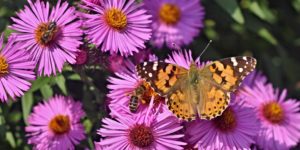
Happy National Pollinator Month! This month, we not only celebrate our honey bees and the sweet honey they provide to us, but we also salute the hard work of other pollinators including butterflies, birds, bats, beetles, and more!
A celebration over fifteen years in the making, National Pollinator Week’s history began when the U.S. Senate approved and designated that a week in June be dubbed “National Pollinator Week,” bringing about greater awareness of the plight of our declining pollinators. Along with the humble honey bee, National Pollinator Week acknowledges the invaluable work of other important pollinators like butterflies, birds, bats, and beetles. In the years since its inception, National Pollinator Week has grown into a month-long international celebration that brings together communities on behalf of our smallest and hardest-working creatures.
A pollinator is an animal or insect that helps plants to make fruit or seeds. Pollination happens by moving pollen from one part of the flower of a plant to another part to fertilize the plant. Seventy-five percent of the world’s food crops rely on pollinators, which underlines how important they are to people and our planet.
In years passed we have shared information on the various types of pollinators, buzz-worthy pollinator facts (though we know that not all pollinators buzz – hello lemurs), and fun ways to celebrate, but this year we want to look more at how our pollinator friends help keep not only our planet healthy but us as well.
It seems fitting in addition to National Pollinator Month, June is also National Fresh Fruit and Vegetables Month. As the temperatures rise, our desire to spend time around a warm oven diminishes and we may find ourselves turning to foods that require less heat to prepare, including a variety of fresh produce. According to fruitsandveggies.org, the goal of National Fresh Fruit and Vegetables Month is to increase the daily consumption of fresh produce, which is not surprising considering that the Center for Disease Control (CDC) claims that in 2019 only 12.3% of adults in the U.S. get enough fruits in their diet, with even less getting to the recommended amount of vegetables (10.0%). There is no denying the importance of fruits and vegetables, we have been encouraged to eat them since childhood, but did you know that including such items in your diet can actually help reduce your risk of a variety of health issues, such as:
- Cardiovascular disease,
- Type 2 diabetes,
- Obesity,
- And even some cancers.
So just how much fruits and vegetables are we supposed to consume? Well, according to the 2020-2025 Dietary Guidelines for Americans, U.S. adults should be consuming 1.5-2 cup-equivalents of fruit and 2-3 cup-equivalents of vegetables each day. While many of us like a variety of fresh produce, not everyone has the same tastes, but honey is here to help! Just like honey can take the most basic dish to the next level, it also brings new flavor (and hopefully renewed interest) to everyday fruits and vegetables. From masking bitter tastes to adding the perfect touch of sweetness to your morning smoothie, we’ve got the honey hacks and recipes that will turn your most reluctant eater into a produce fan.
We want to hear from you! How are you celebrating pollinators this month? Let us know in the comments below.






